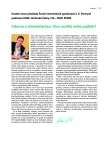Familial hypercholesterolemia – past and present.
My experiences and findings in our group of patients with familial hypercholesterolemia
Authors:
Richard Češka; Michal Vrablík; Tereza Altschmiedová; Martina Prusíková; Zuzana Urbanová; Josef Šobra
Authors‘ workplace:
Centrum preventivní kardiologie III. interní kliniky 1. LF UK a VFN Praha, přednosta prof. MUDr. Štěpán Svačina, DrSc., MBA
Published in:
Vnitř Lék 2014; 60(11): 963-969
Category:
Reviews
Overview
Currently, the familial hypercholesterolemia (FH) rises the interest. The reason is that this genetic disorder is targeted by newly emerged and highly effective hypolipidemic agents, PCSK-9 inhibitors, lomitapid and mipomersen. Present paper discusses 2 patient study groups, before 50 years and nowadays. Although direct statistical analysis is impossible some changes in clinical features of FH might be found over the course of the time. In fact, the basic FH characteristic has not changed dramatically. Severe isolated hypercholesterolemia with total cholesterol 9–10 mmol/l, LDL-cholesterol 7–8 mmol/l and normal values of triglycerides dominates in laboratory analysis. Interestingly, the values of triglycerides increase and almost reach the pathological range in comparison to the values from the period 50 years ago. The values of HDL-cholesterol are normal. Manifestation of CHD in male patients over 40 years of age and in female patients over 50 years of age is not exceptional (rarely occur cases of myocardial infarction in third decade of age). Typical clinical manifestation of FH is xanthomatosis. The early detection and aggressive treatment in FH patients cause that xanthoma tendinosum, xanthelesma and arcus lipoides are less frequent as decades ago. Obesity, diabetes mellitus (DM) and hypertension do not belong to typical clinical sign of FH.
Keywords:
CAD – familial hypercholesterolaemia – HDL-cholesterol – LDL-cholesterol – triglycerides – xanthoma
Sources
1. Nordestgaard BG, Chapman MJ, Humphries SE et al. European Atherosclerosis Society Consensus Panel: Familial hypercholesterolaemia is underdiagnosed and undertreated in the general population: guidance for clinicians to prevent coronary heart disease: consensus statement of the European Atherosclerosis Society. Eur Heart J 2013; 34(45): 3478–3490a.
2. Kastelein JJ, Wedel MK, Baker BF et al. Potent reduction of apolipoprotein B and low-density lipoprotein cholesterol by short-term administration of an antisense inhibitor of apolipoprotein B. Circulation 2006; 114(16): 1729–1735.
3. Horton JD, Cohen JC, Hobbs HH. PCSK9: a convertase that coordinates LDL catabolism. J Lipid Res 2009; 50(Suppl): S172-S177.
4. Qian YW, Schmidt RJ, Zhang Y et al. Secreted PCSK9 downregulates low density lipoprotein receptor through receptor-mediated endocytosis. J Lipid Res 2007; 48(7):1488–1498.
5. Cohen CJ, Boerwinkle E, Mosley TH et al. Sequence variations in PCSK9, low LDL and protection against coronary heart disease. N Engl J Med 2006; 354(12): 1264–1272.
6. Češka R et al. Cholesterol a ateroskleróza, léčba dyslipidémií. 4th ed. Triton: Praha 2012. ISBN 978–80–7387–599–2.
7. Hobbs HH, Brown MS, Goldstein JL. Molecular genetics of the LDL receptor gene in familial hypercholesterolemia. Hum Mutat 1992; 1(6): 445–466.
8. Rader DJ, Cohen J, Hobbs HH. Monogenic hypercholesterolemia: new insights in pathogenesis and treatment. J Clin Invest 2003; 111(12): 1795–1803.
9. Innerarity TL, Weisgraber KH, Arnold KS et al. Familial defective apolipoprotein B-100: low density lipoproteins with abnormal receptor binding. Proc Natl Acad Sci USA 1987; 84(19): 6919–6923.
10. Qian YW, Schmidt RJ, Zhang Y et al. Secreted PCSK9 downregulates low density lipoprotein receptor through receptor-mediated endocytosis. J Lipid Res 2007; 48(7): 1488–1498.
11. Garcia CK, Wilund K, Arca M et al. Autosomal recessive hypercholesterolemia caused by mutations in a putative LDL receptor adaptor protein. Science 2001; 292(5520): 1394–1398.
12. Brown MS, Goldstein JL. A receptor-mediated pathway for cholesterol homeostasis. Science 1986; 232(4746): 34–47.
13. Gudnason V, Sigurdsson G, Nissen H et al. Common founder mutation in the LDL receptor gene causing familial hypercholesterolaemia in the Icelandic population. Hum Mutat 1997; 10(1): 36–44.
14. Tichý L, Freiberger T, Zapletalová P et al. The molecular basis of familial hypercholesterolemia in the Czech Republic: Spectrum of LDLR mutations and genotype-phenotype correlations. Atherosclerosis 2012; 223(2): 401–408.
15. Chmara M, Wasag B, Zuk M et al. Molecular characterization of Polish patients with familial hypercholesterolemia: novel and recurrent LDLR mutations. J Appl Genet 2010; 51(1): 95–106.
16. Nauck MS, Koster W, Dorfer K et al. Identification of recurrent and novel mutations in the LDL receptor gene in German patients with familial hypercholesterolemia. Hum Mutat 2001; 18(2): 165–166.
17. Widhalm K, Dirisamer A, Lindemayr A et al. Diagnosis of families with familial hypercholesterolaemia and/or Apo B-100 defect by means of DNA analysis of LDL-receptor gene mutations. J Inherit Metab Dis 2007; 30(2): 239–247.
18. Fahed AC, Nemer GM. Familial hypercholesterolemia: the lipids or the genes? Nutr Metab (Lond) 2011; 88(1): 23.
19. Šobra J. Familiární hypercholesterolemická xanthomatosa. Avicenum: Praha 1970.
Labels
Diabetology Endocrinology Internal medicineArticle was published in
Internal Medicine

2014 Issue 11
Most read in this issue
- New aspects of hormone replacement therapy
- LDL-apheresis in the treatment familial hypercholesterolemia
- New SGLT2 inhibitor empagliflozin: modern and safe treatment of diabetes
- Extended options of anticoagulant treatment in thromboembolism
